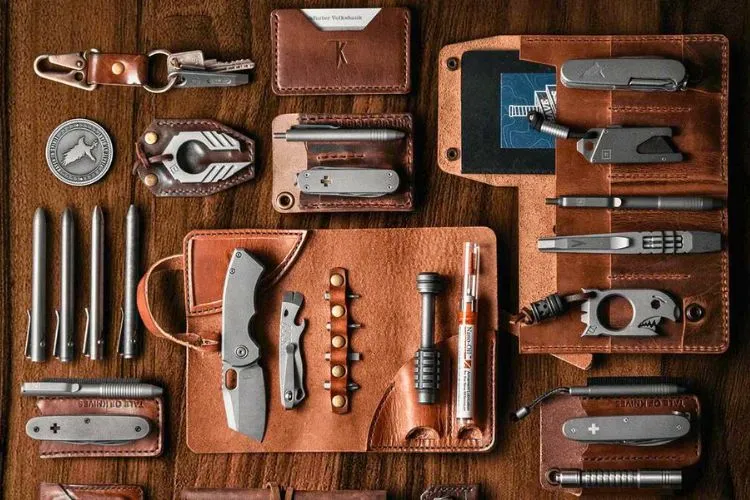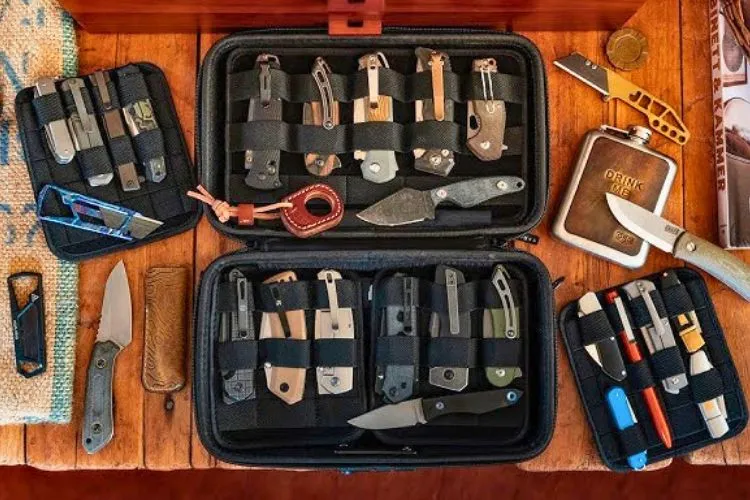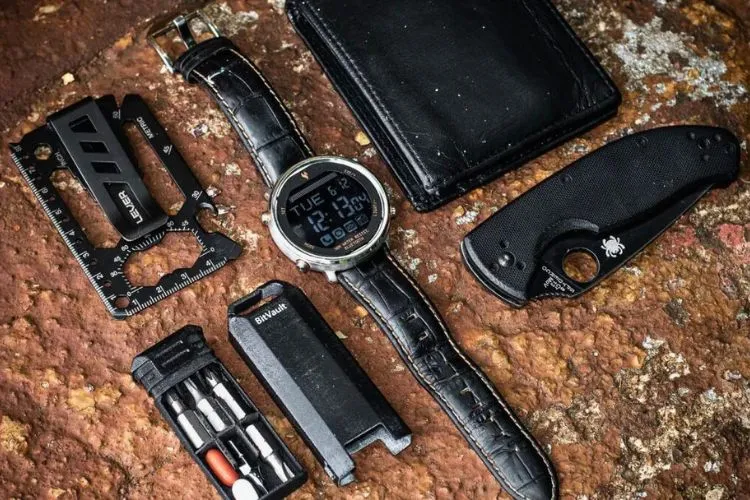The elements of one’s everyday carry (EDC) represent the unique blend of necessities and comforts that they don’t leave home without.
Over time, changing circumstances, technological advances, or personal needs can evoke shifts in these basic essentials.
One question many EDC enthusiasts often muse upon is “How often do you change EDC gear?”.

This article explores this intriguing topic, delving into the reasons why individuals might regularly update their EDC gear, the benefits of doing so, and some best practices to make the process easier.
Let’s decode the evolving world of EDC together.
how often do you change edc gear?
It depends heavily on individual needs and preferences. However, a dynamic and evolving EDC set can often provide the most functionality. This guide sheds light on various aspects influencing gear change and sharing insights on best practices.
Evaluating your Current Gear
Before introducing changes to your EDC, take the time to evaluate your existing gear. Ask yourself about their functionality, utility, and your comfortability with each one of them. Recognize your most-used items and analyze if there is a need to swap them out occasionally.
Reason to Change Your EDC Gear
- Wear and Tear: One of the most common reasons to change EDC gear is wear and tear. Constant use can lead to damage that might result in unreliable functionality.
- Technology Advancements: With the rapid evolution of technology, you might find a newly released product that’s more handy and efficient than your current ones.
- Change in Routine or Environment: If your job or daily routine changes significantly, or if you move to a different environment, it could necessitate an update.
- Minimalist Approach: Over time, you may realize you’re carrying more than necessary and decide to pare down your EDC.
Frequency of Change
There are no hard and fast rules for how often you need to change your EDC gear. It’s all about tuning into what works best for you:
- Regular Checks: Monthly checks are a good start. This allows you to correct redundancies and add necessary items timely.
- Seasonal Shifts: Depending on the weather conditions, you might need specific items more than others. For example, a compact umbrella or allergy medicine might become crucial in rainy or spring seasons respectively.
- Yearly Updates: A yearly refresh would work for those whose gear don’t require frequent changes and who don’t subscribe to the latest tech or trend.
Updating EDC Gear: Best Practices
- Carry Essentials: The fundamental principle for EDC gear is to carry what’s vital for you. Don’t get swayed by fancy trend unless it’s beneficial.
- Quality Over Quantity: Choose durable and reliable gear. Though quality items may cost more upfront, they can be more cost-effective in the long run as they may require fewer replacements.
- Functionality Over Aesthetics: It’s very human to be attracted to good looks. But in EDC terms, function should outweigh form.
- Regular Review: Even though you’ve formed a set, remember to review it periodically.
While personal preference dictates the frequency of changing EDC gear largely, this guide offers insight on the matter. With a focus on the functionality of the items, and by staying in tune with personal needs and circumstances, one can capitalize on the benefits of a well-curated EDC kit.
Maintaining EDC Gear: Tips and Tricks for Longevity
The key to ensuring your everyday carry (EDC) gear lasts is regular maintenance and adequate care. In addition to saving you money over time, proper maintenance can enhance gear performance and ensure it serves you well when you need it most.
Here’s a detailed guide on maintaining your EDC gear for maximum longevity.

Understanding the Nuances of your EDC Gear
Each item in your EDC gear has its unique care needs informed by its composition, function, and use frequency. Read up on manufacturer guidelines and general best practices for each item’s maintenance.
- Metal Items: Metal items such as knives, multi-tools, or keys need regular cleaning and lubricating to prevent rust and maintain optimal function.
- Electronic Devices: Devices like flashlights, power banks, or other tech gadgets require safe storage, careful handling to prevent falls or crashes, and regular software updates.
- Leather Goods: Leather wallets, holsters, or belts need conditioning to keep them soft and to prevent cracking.
- Textiles: Textile items like handkerchiefs or bandanas should be laundered regularly to maintain hygiene.
Regular Cleaning and Inspection
Regular cleaning and inspection are essential. This not only keeps your items in top shape but also lets you spot any damage or potential problems early on.
- Daily Quick Clean: A daily quick clean after use can prevent grime buildup. This could be as simple as wiping down your knife or keys with a clean cloth.
- Weekly to Monthly Detailed Inspection: Set aside time for a thorough cleaning and inspection of your gear. This means disassembling where safe and possible, such as with multi-tools, deep cleaning, and checking for damage or wear.
Safe Storage and Handling
Proper storage preserves the longevity of your gear. When not in use, store items in a cool, dry place and out of direct sunlight. Avoid over-stuffing items into pockets or bags to prevent scratches and damage.
Scheduled Servicing and Repairs
Complex items like digital watches, electronic gadgets, or specialized tools may require professional servicing or repairs to maintain their lifespan. Keep track of recommended service intervals and set reminders, so you don’t forget.
Mindful Usage
Proper use significantly influences the durability of your gear. Avoid using items beyond their capacity or in ways they weren’t designed for.
Regular Rotation
Rotating your gear can also help with longevity. Consider having different setups for different needs instead of using the same gear every day.
Maintaining your EDC gear is an often overlooked, but vital process that aids in extending the lifespan of your items. With these tips, you can enjoy the full capability of your gear for a longer time. Remember, a well-loved tool is a long-lasting tool.
Essential Aspects to Evaluate When Considering EDC Gear Change
Everyday Carry (EDC) gear is an essential part of our daily routine, providing functional solutions for mundane or unexpected problems.
As our lifestyles and needs evolve, so must our EDC. But what aspects should we consider when thinking about changes to our setup? Here, we explore these pivotal factors in detail.

Functionality
Perhaps the most critical aspect to evaluate in EDC gear is its functionality. Does it serve a purpose or solve a problem in your everyday life? If not, consider replacing it with an item that does.
- Utility: Are the functions of the gear still relevant to your everyday life, or could another tool perform these functions better?
- Frequency of Use: How often do you use the item? If it rarely comes out of your pocket or bag, it may be worth re-evaluating its place in your EDC.
Condition
The physical condition of your gear also dictates whether it’s time for a change. Regular inspection for wear and tear, functionality, and cleanliness is crucial.
- Wear and Tear: Do your EDC items show signs of excessive wear, such as cracks, dull blades, or broken components? If so, they may require replacement.
- Functionality: Are all components still working correctly, or are there signs of failure or decreased performance? This might suggest the need for an update.
Technological Advancements
Year after year, technologically enhanced tools and devices appear on the market. These advancements may offer more functionality or efficiency than your current gear.
- New Features: Newer versions of items often come with improved features that can elevate the value your gear provides in your daily routine.
- Improved Efficiency: Many new-edition items offer improved power efficiency, particularly for electronically powered tools. This could extend usage times or minimize the inconvenience of regular charging or battery changes.
Changed Needs and Circumstances
Our daily routines and needs change over time and these changes should be reflected in our EDC gear.
- Lifestyle Changes: Significant changes to your job, environment, or personal life can require revisions to your EDC. For example, starting a new outdoor job might necessitate carrying sunscreen or sunglasses.
- Seasonal Changes: As seasons change, so do our everyday needs. Maybe you need an umbrella for rainy seasons, or a multi-tool for summer camping trips.
Comfort and Portability
EDC items should be comfortable to carry and easily accessible. Bulky, heavy, or improperly balanced gear can be a hindrance, which can necessitate a gear change.
- Weight: If your EDC is too bulky or heavy and a more lightweight version of an item is available, a switch might be worth considering.
- Size: Size is another factor—more compact versions offer the same functionality but with greater portability.
By evaluating these aspects regularly, you can ensure your EDC gear remains relevant, functional, and valuable, offering you the tools you need when and where you need them most.
Conclusion:
There is no universal answer to how often you should change your Everyday Carry (EDC) gear. Personal preferences, environmental factors, technological advancements, and lifestyle changes contribute to the decision-making process.
It’s crucial to periodically evaluate your EDC gear based on its condition, functionality, and relevance to your current needs. A mindful revisiting and possible revision of your EDC gear will ensure an optimal and practical everyday carry that suits your lifestyle best.
Ultimately, it’s about striking a balance between what’s necessary, what’s useful, and what’s reliable for you.


